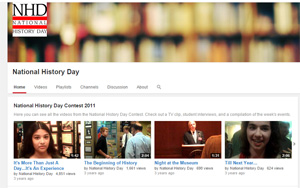 History comes in many forms: oral stories passed down from generation to generation, images capturing a specific time and place, documents representing written thoughts, and video clips revealing the sounds and motion of real people and events. Each form provides artifacts of the past for historical inquiry and interpretation. For decades, historians have engaged in online historical inquiry by conducting research with multimodal sources (audio clips, still images, video) to create a visual interpretation of the past through documentary film. Since access to digital archives and free video editing software has increased, it is exciting to think about how we might engage students in the online historical inquiry practices used by professional historians.
History comes in many forms: oral stories passed down from generation to generation, images capturing a specific time and place, documents representing written thoughts, and video clips revealing the sounds and motion of real people and events. Each form provides artifacts of the past for historical inquiry and interpretation. For decades, historians have engaged in online historical inquiry by conducting research with multimodal sources (audio clips, still images, video) to create a visual interpretation of the past through documentary film. Since access to digital archives and free video editing software has increased, it is exciting to think about how we might engage students in the online historical inquiry practices used by professional historians.
When implementing digital video composition in history classrooms, students first analyze and interpret sources by repeatedly entering online archives to select or reject sources that will answer their questions. Then, they shape their narrative for the purpose of representing the past through a short student-created documentary. Take a moment to watch the winning student-created documentary for the 2014 National History Day competition.
According to Kathy Swan and Mark J. Hofer, online historical inquiry is most effective when educators scaffold the digital video composition process through four stages: research, documentary treatment, storyboard, and film production. Additionally, providing formative assessment during all four stages through informal conferences and formal rubrics supports students’ historical thinking.
Research—Students enter online digital archives to select and interpret multimodal sources and then take detailed notes to document their interpretation of different historical perspectives. Throughout this stage, the teacher is modeling how to conduct a close reading with annotations and showing short clips of documentaries to analyze the digital video composition process. Educators can access most of the National History Day documentaries for free on YouTube.
Documentary Treatment—Students synthesize their notes into a script to facilitate corroboration and contextualization of sources. Educators may want to scaffold this process by having students work on one section of the script each day (the opening, the events, the defining moment, the conclusion, the resolution). After creating a script outline, students present their documentary treatment with the intention of receiving formative feedback about their main thesis and scene-by-scene overview.
Storyboard Phase—Students create a storyboard by aligning multimodal sources with the script. Next students blend music and recorded narration with filmmaking effects. There are numerous video-editing tools available for composing student-created documentaries that are software-based (iMovie, Garageband, Final Cut Pro, Photo Story 3 and Movie Maker) or Web-based (Animoto, PrimaryAccess, Weavly, Wevideo).
Film Production—Students take their digital video composition from private to public by presenting their work to their peers or outside audiences. By entering student-created documentaries in national contests or uploading their documentaries to public websites like YouTube or TeacherTube, students have the opportunity to add to the general body of historical knowledge.
Repurposing online historical inquiry to include digital video composition may serve as an innovative way to address several academic standards. Creating meaning from multimedia sources are increasingly important learning outcomes as defined by English Language Arts Common Core State Standards (CCSS), College, Career, and Civic Life (C3) Framework, and National Council for the Social Studies Guidelines (NCSS). Students are expected to analyze how visual elements contribute to the meaning of a text and encouraged to include multimedia components in their presentations. Additionally, there is a stronger emphasis on embedding English Language Arts standards within history classrooms. In today’s high-stakes testing environment, educators do not have the freedom to ignore learning outcomes defined by state and local academic standards, nor do educators have time to teach them in isolation. Since online historical inquiry involves conducting research, asking questions, and analyzing multimodal sources, social studies classes may provide the ideal context for integrating digital video composition to develop 21st century skills and discipline-specific skills simultaneously.
 Julie B. Wise is a doctoral student at the University of Delaware. She can be reached at jbwise@udel.edu.
Julie B. Wise is a doctoral student at the University of Delaware. She can be reached at jbwise@udel.edu.